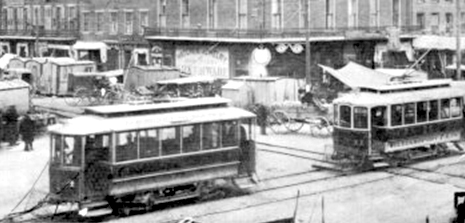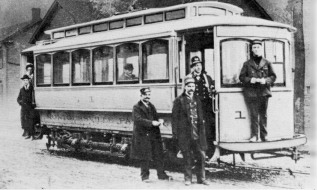
In the city of Williamsport itself, there was great growth and prosperity in the mid-1800’s. These were the days of the Lumber Boom, and throughout the nation Williamsport was known as a town of millionaires. These millionaires, in an expression of civic pride and ambition, provided the funds and impetus for the development of Williamsport’s first form of intracity public transportation – the streetcar. There followed an exciting era in local transportation marked by a number of innovations and many controversies.
The population of Williamsport had increased to around 6,000 when, on April 15, 1863, Governor Andrew G. Curtin signed a charter creating the Williamsport Passenger Railway Company. This charter gave the company the right to build branches through any of the streets of Williamsport with either single or double track. For one reason or another, it was not until a year later that construction of a railway line actually began, and only then because of the efforts of Peter Herdic. He, in addition to being Williamsport’s leading industrialist and entrepreneur of the 19th century, was also the inventor of the Herdic, a horse-drawn carriage with side seats and a back entrance, a forerunner of the taxicab
The original line of the Williamsport railway extended roughly 1. 1 miles from Market Street west on Third Street to Pine and north on Pine to Fourth, then west on Fourth to the newly constructed Herdic House, now the Park Home. The first streetcars were placed in service on this line in 1865 in time for the State Fair held in Williamsport that September. These cars were noisy, swaying vehicles drawn by horses and equipped with small stoves to keep passengers warm In the winter. In 1870 enclosed sleighs were brought into service for operation when deep snows made the passage of other vehicles impossible.
At first, Herdic used large, 26-passenger cars requiring two horses and provided 94 trips per day. However, this quickly proved to be too much service, and smaller, 16-passenger cars requiring only one horse were soon introduced.
The Williamsport Company was not very successful under Herdic’s control. In 1875 the system carried 220,643 passengers, but profits were insufficient to make any improvements. In 1879 control of the company passed from Herdic to Robert P. Allen, and then in 1886 to John Lawshe, a newcomer to the city who had already become influential in banking circles.
It was under Lawshe’s control that the company began its first major expansion – no doubt largely because its monopoly of Williamsport’s streets was being challenged for the first time. In 1887 the Common Council granted rights to the recently organized Peoples’ Passenger Railway Company to build seven miles of lines, mainly in South Williamsport. However, this threat to the Williamsport Company never came to anything as the Pennsylvania Act of 1878, under which the People’s charter was granted, was found to be unconstitutional
Also in 1887, the Williamsport Company engaged in its first legal battle. The Company had begun constructing extensions on Third and Fourth Streets when the City secured an injunction stopping all construction until the City had officially given its approval. The Company went to court, arguing on the basis of their original charter. Even though this charter gave them more control than that enjoyed by any other horse railway in the state, the State Supreme Court found in the Company’s favor, and the various extensions were opened on September 1, 1888. This dispute was just the beginning of the conflicts between the City and the Williamsport Passenger Railway Company concerning right of use and responsibility for street maintenance.
In 1890, the Williamsport Company was purchased for $125,000 by a Philadelphia syndicate headed by local resident Hiram Rhoads, who was also head of the Williamsport and North Branch Telephone Company and secretary of the Lycoming Electric Company. Under Rhoads, electrification of the system was begun, and on August 5 and 6, 1891, several successful trial runs were held on the reconstructed Third Street line. With these electric cars in operation, Williamsport was ahead of its time: even Philadelphia could not boast of electric streetcars for another year.
Two electric trolleys travel through market square around the turn of the century
The new cars were an immediate success with city residents. As reported in the Grit on August 9, 1891: “and the people Williamsport has rapid transit at last, are as proud of the new electric cars as a boy is of a new toy. They are a novelty, and are being enjoyed as such by everybody . . .”
Within three months the Fourth Street line was also electrified, and service initiated on November 14. These lines operated 20 hours a day, from 5:05 a.m. to 1:40 a.m. the following day.
In 1892 the Company built an extension to Newberry by way of Cemetery Street and Erie Avenue. A separate company, the Newberry Bridge Company, was formed to construct a bridge across Lycoming Creek at Blaine Street. This bridge was exclusively for the use of streetcars; the costs of its construction were partially defrayed by a one-cent toll on each passenger who was transported across.
As the popularity of streetcars grew, it was inevitable that the monopoly of the Williamsport Passenger Railway Company would again be challenged. In the early months of 1892 charters were granted to six new companies -the Vallamont Passenger Railway, Citizens’ Passenger Railway, and the South Side Passenger Railway, all under the control of J. Henry Cochran; the Junction Passenger Railway Company; the Centre and West End Passenger Railway Company, and the East End Passenger Railway Company.
The ensuing struggle over the rights to occupy Williamsport’s streets soon erupted into the so-called “Streetcar War.” On April 8 the Junction Company received a charter which gave it the right to connect the proposed South Side and Vallamont Railway lines. The logical route was Market Street. The Williamsport Passenger Railway Company was not prepared to stand for this, and so, acting under its blanket rights, it began laying tracks along the length of Market Street just six days after the junction Company was chartered. The latter company retaliated by ripping out the tracks as soon as they were laid. It also sought relief from the courts and was granted a preliminary injunction. The legal battle that followed went as far as the State Supreme Court which on May 16, 1893 ruled against the Williamsport Company. This decision was a reversal of the Court’s 1887 ruling and marked the end of the Company’s monopoly. During this period, the local press reported continuously on the course of events, publishing a number of caricatures of Hiram Rhoads that poked fun at his attempts at empire building.
Soon after the Williamsport Company’s monopoly was broken, the competing companies began constructing their own lines. On May 30, 1893 the East End Company opened service on its line which ran up Franklin Street hill and back down via Lincoln, Almond, and Washington Boulevard. And, on August 1, 1893, the Vallamont loop offering service to the Vallamont section of the city was officially opened.
On February 17, 1894, Hiram Rhoads died suddenly at the age of 49. Within a month, Cochran founded a new company, the Lycoming Improvement Company, which shortly thereafter purchased the capital stock of the Williamsport Passenger Railway Company. At about the same time, four of the other railway companies – the Vallamont, the Citizens’ Passenger, the Centre and West End, and the Junction – were merged to form the Vallamont Traction Company, also controlled by Cochran. And, by the end of 1894, Cochran acquired the last of the independents, the East End Company. Thus, ironically, within a year of Rhoads’ death, Cochran was able to achieve the monopoly that Rhoads had so vigorously but unsuccessfully tried to maintain.
Since all the railways were now under a single management, a single fare was instituted on August 14, 1894 which allowed passengers to ride anywhere within the railway system for five cents. The entire system was known by the name of the Williamsport Passenger Railway Company.
Also in 1894, construction was begun on the first line extending service outside the city limits. On March 9, 1895 service on the South Side Railway was officially begun. Although a separate corporation, this railway was also under the control of the Lycoming Improvement Company. The tracks crossed the Susquehanna on a cantilever attached to the east side of the Market Street bridge, ran south on Market to Southern Avenue, then west to Maynard Street and back.
Almost since the day electric cars were introduced, accidents had been a concern of some citizens. Most accidents were blamed on excessive speed, which reached about twenty miles per hour. Responding to public outrage over the problem, City Council passed an ordinance in 1895 limiting streetcar speed to eight-to-ten miles per hour.
In 1897, a second line running outside the city went into service. This was the Montoursville line, owned and operated by the Montoursville Passenger Railway Company, which in turn was owned by a Philadelphia firm, the Tennis Construction Company. The line connected with the Third Street line in Williamsport, and a passenger could travel from Montoursville to Market Square for ten cents. The cars ran every half-hour and the trip took 30 minutes, about half the time it had previously taken by horse-and-buggy or train.In the borough itself, one line ran down Broad as far as Walnut Street. The other traveled down Broad to Montour Street, then north to Loyalsock Avenue and west for one block. In 1898 this line was extended north to Starr Island, a popular recreation area along Loyalsock Creek.

The period from the 1890’s to about the time of World War I was the heyday of streetcar service in Williamsport. Trolley parties were very popular during the summer months, and parents would often charter a car for an evening for childrens’ outings. The streetcars also did a good business carrying ‘dents to the local recreation areas. The Vallamont loop, for example, served a nine-hole golf course located west of Woodmont Avenue, as well as Vallamont Park. For ten cents residents got a round-trip ride to the park plus free admission to a matinee performance in the pavilion. In addition, the loop served Athletic Park, home of the Williamsport Millionaires of the Tri-State Baseball League.
In the east end of Williamsport, there was Union Park. And in Montoursville, there was Starr Island. This wooded park, opened in 1898, offered picnic grounds, boating facilities, and a bathing area. Later, in 1909, it was renamed Indian Park and became a large and very popular amusement park.
Squabbles with their respective municipalities over maintenance and repair of the streets dogged both the Williamsport and Montoursville railway companies. In 1891, the Williamsport City Council passed an ordinance levying a $50 annual tax on each streetcar to help pay for the costs of street maintenance. (This tax remained in effect until 1926.) In 1900 the issue came to a head when the city was repaving several of the main thoroughfares with improved paving. The streetcar company refused to do the same, and the city went to court. The State Supreme Court eventually ruled in favor of the company, stating that their only obligation was to maintain the paving between the tracks, not to repave with new and different paving. Similarly in Montoursville, the Loyalsock Township supervisors went to court seeking to compel the railway company to keep the roadway in repair. In this case the referee ruled in favor of the township and the company was required to pave the space between the tracks with macadam.


